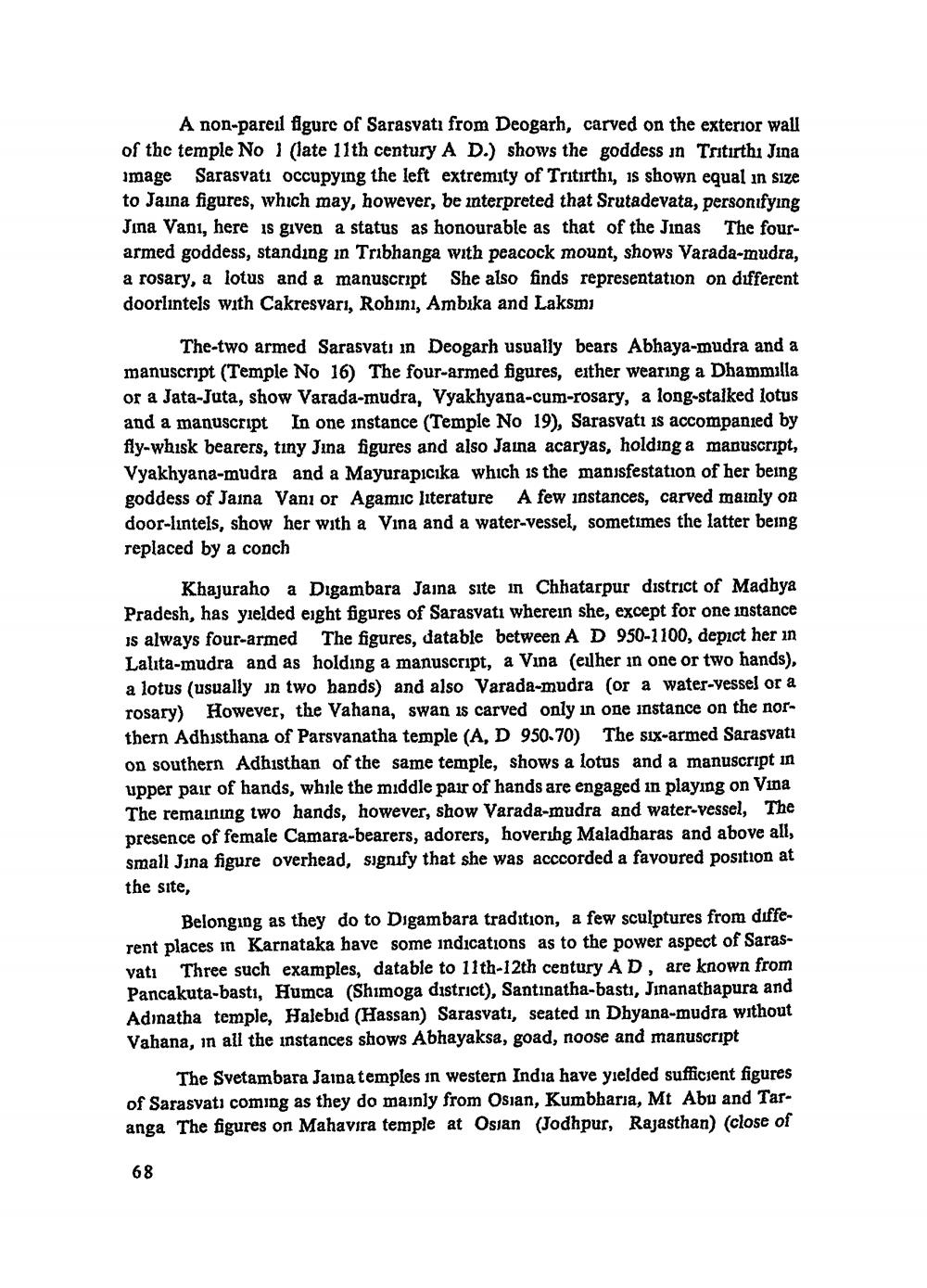________________
A non-pareil figure of Sarasvati from Deogarh, carved on the exterior wall of the temple No 1 (late 11th century A D.) shows the goddess in Triturthi Jina image Sarasvati occupying the left extremity of Tritirthi, is shown equal in size to Jaina figures, which may, however, be interpreted that Srutadevata, personifying Jina Vanı, here is given a status as honourable as that of the Jinas The fourarmed goddess, standing in Tribhanga with peacock mount, shows Varada-mudra, a rosary, a lotus and a manuscript She also finds representation on different doorlintels with Cakresvari, Robini, Ambika and Laksmi
The-two armed Sarasvati in Deogarh usually bears Abhaya-mudra and a manuscript (Temple No 16) The four-armed figures, either wearing a Dhammilla or a Jata-Juta, show Varada-mudra, Vyakhyana-cum-rosary, a long-stalked lotus and a manuscript In one instance (Temple No 19), Sarasvati is accompanied by fly-whisk bearers, tiny Jina figures and also Jaina acaryas, holding a manuscript, Vyakhyana-mudra and a Mayurapıcıka which is the manisfestation of her being goddess of Jaina Vani or Agamic literature A few instances, carved mainly on door-lintels, show her with a Vina and a water-vessel, sometimes the latter being replaced by a conch
Khajuraho a Digambara Jaina site in Chhatarpur district of Madhya Pradesh, has yielded eight figures of Sarasvati wherein she, except for one instance is always four-armed The figures, datable between A D 950-1100, depict her in Lalıta-mudra and as holding a manuscript, a Vina (eulher in one or two hands), a lotus (usually in two hands) and also Varada-mudra (or a water-vessel or a rosary) However, the Vahana, swan is carved only in one instance on the northern Adhisthana of Parsvanatha temple (A, D 950.70) The six-armed Sarasvati on southern Adhisthan of the same temple, shows a lotus and a manuscript in upper pair of hands, while the middle pair of hands are engaged in playing on Vina The remaining two hands, however, show Varada-mudra and water-vessel, The presence of female Camara-bearers, adorers, hoversbg Maladharas and above all, small Jina figure overhead, signify that she was acccorded a favoured position at the site,
Belonging as they do to Digambara tradition, a few sculptures from different places in Karnataka have some indications as to the power aspect of Sarasyatı Three such examples, datable to 11th-12th century AD, are known from Pancakuta-basti, Humca (Shimoga district), Santinatha-basti, Jinanathapura and Adinatha temple, Halebid (Hassan) Sarasvati, seated in Dhyana-mudra without Vahana, in all the instances shows Abhayaksa, goad, noose and manuscript
The Svetambara Jaina temples in western India have yielded sufficient figures of Sarasvati coming as they do mainly from Osian, Kumbharia, Mt Abu and Taranga The figures on Mahavira temple at Osian (Jodhpur, Rajasthan) (close of
68




